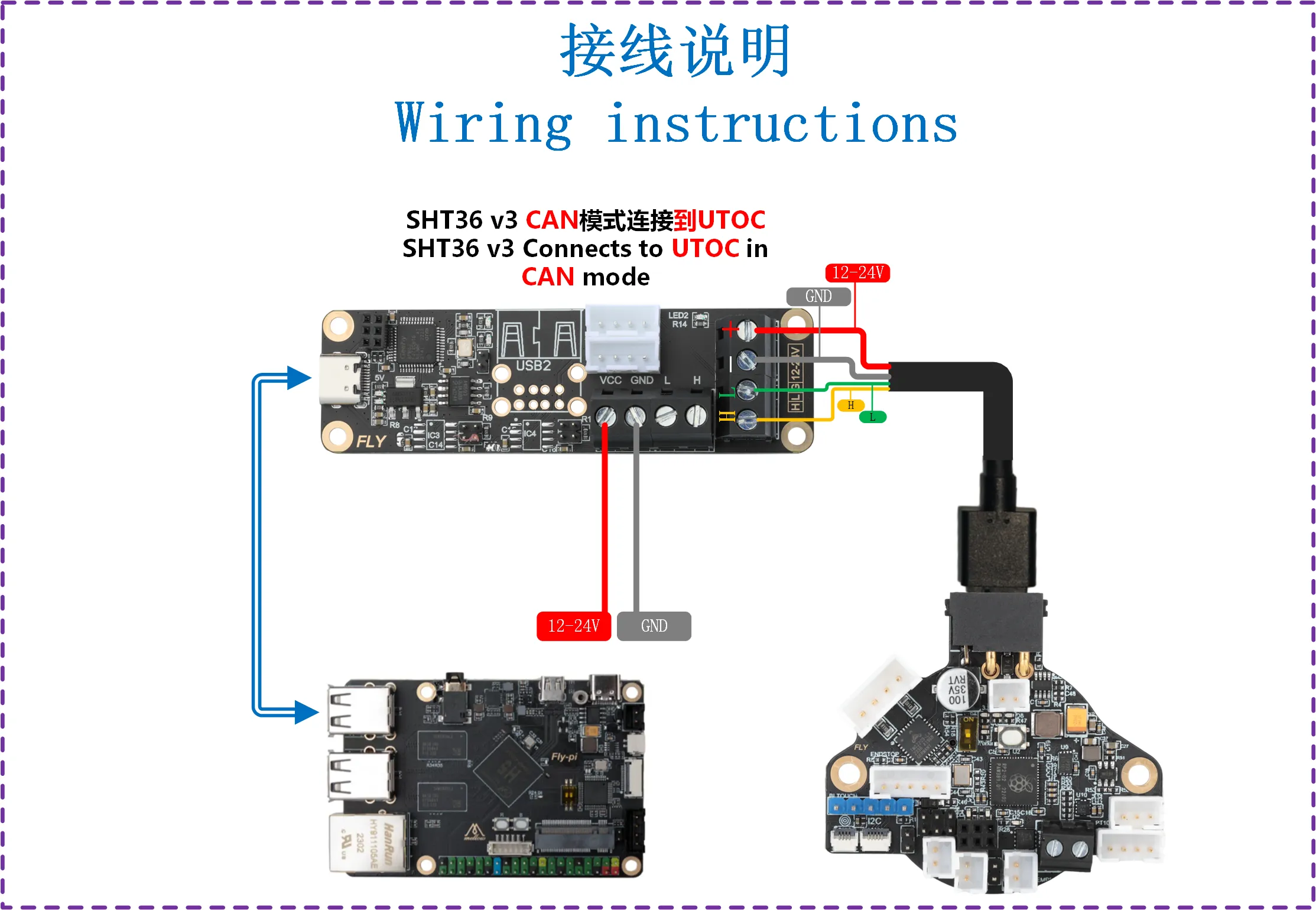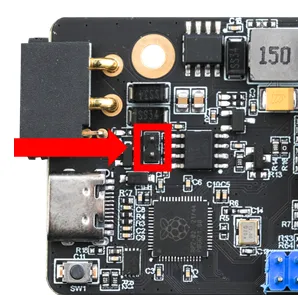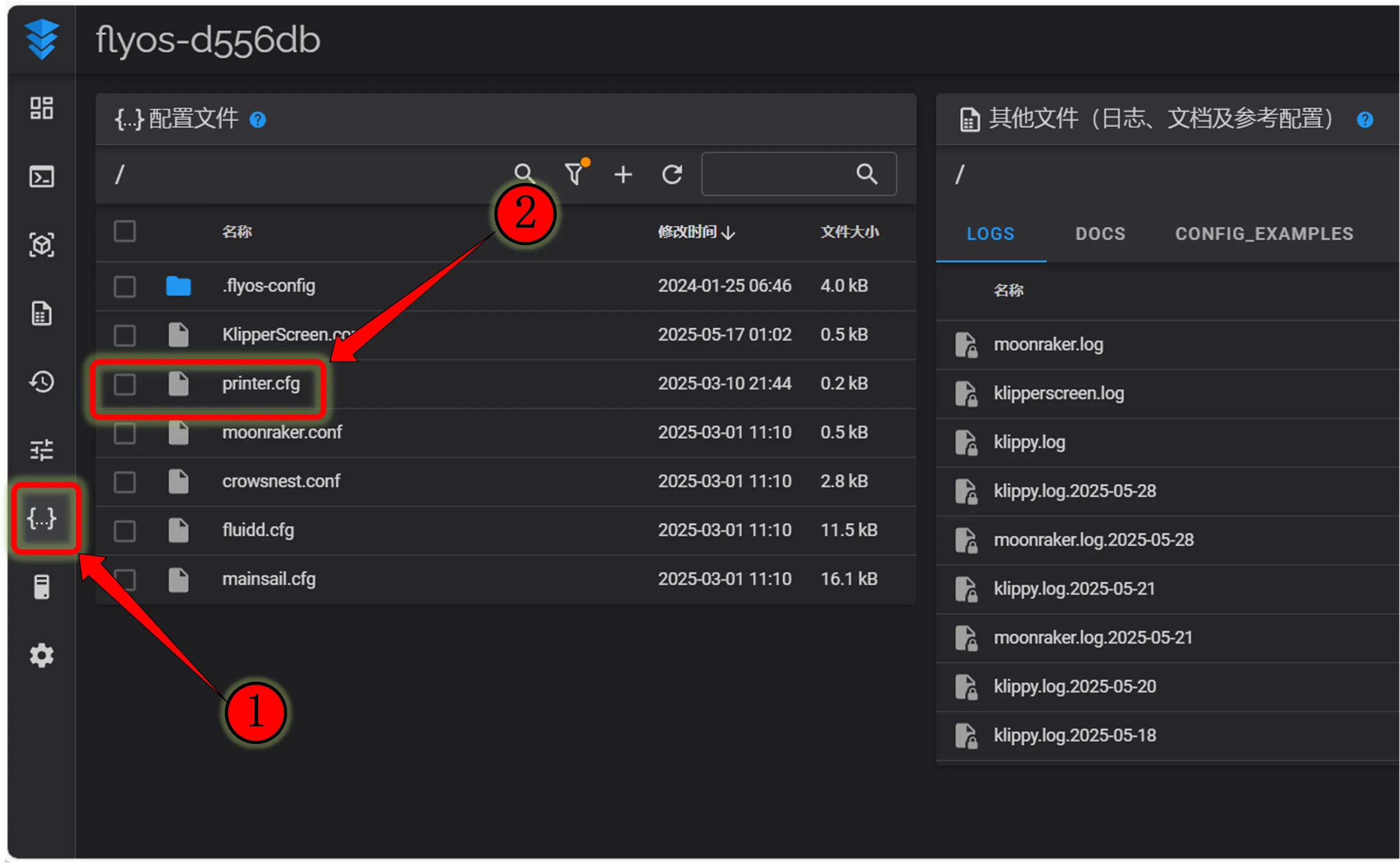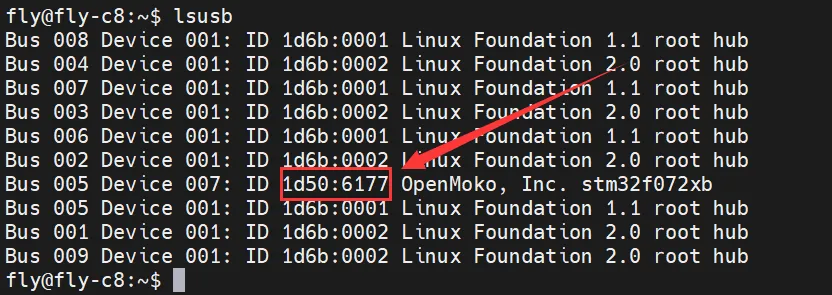Motherboard ID Reading and Viewing
Please do not modify the configuration when translating the webpage
Please do not modify the configuration when translating the webpage
Please do not modify the configuration when translating the webpage
- CANBus UUID Acquisition
- USB ID Acquisition
- Before searching for the ID, connect the tool board to the UTOC or the motherboard with the bridge firmware flashed using the XT30 data cable, and the reference wiring diagram is below

- Please ensure that the CAN H and CAN L are measured with a multimeter at around
60Ωunder power-off conditions. If it is120Ω, you need to connect a120Ωjumper. If it is around40Ω, you need to remove the jumper
CAN Configuration and ID Search
- If you need to use CAN, make sure your host computer has performed CAN configuration
NotesMake sure the mainboard is connected to the host computer before proceeding with the following operations
warningEnsure that the CAN network of the host computer, the CAN speed of the bridge mainboard, and the CAN tool board's speed are completely consistent
Precautions Before Searching for Devices
- Before searching for CAN ID, please connect to SSH
- Please note that you need to log in to SSH via the network, not via the serial port
- Make sure you have connected the UTOC or flashed the CAN bridge firmware on the mainboard, and ensure that the data cable connected to the host computer has data transmission functionality
Search for Devices
- Now that you have successfully logged in to the host computer, you can enter
lsusbto search for devices, which will result in one of the following situations- Entering
lsusbprompts that thelscommand is not found, then you can enter the following command to install the commandsudo apt-get install usbutils - Entering
lsusbresults in no response, this is a system issue, we cannot do anything about it, you need to change the system or use a confirmed normal system - The information in the image below appears, please note that this is just a reference. You only need to confirm that
1d50:606fappears
- Entering
1d50:606fis the device you need to use this time- If there are multiple
1d50:606f, it is recommended to exclude one, otherwise it may affect subsequent burning and firmware connection. For example,FLY MINI PADis recommended to use the built-in UTOC instead of other CAN bridge devices - If not, please check yourself whether the data cable is connected properly and whether the firmware is flashed correctly.
NotesYou can only search for CAN ID when there is
1d50:606fSearch for CAN ID
- Enter the following command to search for ID
~/klippy-env/bin/python ~/klipper/scripts/canbus_query.py can0- FAST system uses the following command
python ~/klipper/scripts/canbus_query.py can0- If an ID appears and the
Application:at the end showsKlipper, it means this ID can be used directly - If an ID appears and the
Application:at the end showsCANBOOTorKatapult, it means the firmware needs to be flashed before it can be used
CAN Problem Collection
Notes- If you cannot find the CAN ID, please see the following document
- CAN Problem Collection
Enter the CAN ID into the configuration
- Fluidd is:
{…}, click to enter, you can findprinter.cfg

- Mainsail is:
machine, click to enter, you can findprinter.cfg

-
Copy the queried UUID and enter it into the
canbus_uuid:node under the[mcu]section in theprinter.cfgconfiguration. After saving and restarting, the mainboard can be connected. If Klipper indicates that the firmware needs to be updated, ADC error etc., it means Klipper has already connected to the mainboard -
If
Application:shows Canboot, it cannot be configured into the configuration, and you need to flash the Klipper firmware to proceed dangerous
dangerousNote: All IDs mentioned in the document are examples. The actual ID of each mainboard is different. Please modify and fill in according to the actual obtained ID.
-
The following is a reference configuration
dangerous[mcu]
canbus_uuid: <Replace this with the ID you just queried>- The following is a reference configuration for a mainboard plus a toolboard
- If it is a mainboard ID, it must be
[mcu]pluscanbus_uuid:plus the ID you searched for - If it is a toolboard, it must be
[mcu toolboard name]pluscanbus_uuid:plus the ID you searched for
-
Please prepare a data cable with data transmission function. If the length is particularly long, it is recommended to use a data cable with a magnetic ring
Search USB Tutorial
Precautions Before Searching for Devices
- Please connect to SSH before searching for the USB ID Connect to SSH
- Please note that you need to ensure that you log in to SSH via the network rather than via serial port
- Please ensure that the mainboard with the flashed USB firmware is connected, and the data cable connecting to the host computer has data transmission function
Search for Devices
- Ensure that the host computer can connect normally to the network, and ensure that the data cable connecting the downstream device to the host computer has data transmission function.
- After SSH connection to the host computer, enter
lsusband press Enter. If the information circled in the image below appears, you can proceed to the next step.- If there is no feedback at all, this is a system problem with the host computer. We are unable to help. You need to replace it with a confirmed normal system or replace the host computer.
- If the prompt says there is no
lsusbcommand, you can execute the following command to install:sudo apt-get install usbutils
1d50:6177belongs to the device you will use this time.- Some host computers may not display fully or not display due to system issues.
- If the
lsusbcommand can display the device but does not show1d50:6177, please try replacing the data cable and connecting the mainboard to another USB port on the host computer.
- If you have executed the above steps before and successfully burned the Klipper firmware, the mainboard is running normally, and you just need to update the Klipper firmware, please directly refer to the
Firmware Updatesection in the right-hand menu bar of this page.
NoteYou must query the
1d50:6177device before proceeding to the next stepSearch for USBID
ls /dev/serial/by-id/*- Enter the command below and press Enter. If everything is normal, one blue ID will appear. (The following is for reference only)

- If no ID appears after entering the command below, but
lsusbshows the device, please replace the host computer or the host computer system.
NoteIf multiple IDs appear, please select the corresponding ID based on your mainboard's MCU model.
Fill in the USB ID into the configuration
-
Open the printer web interface, find
printer.cfgunder the configuration option in the left sidebar: fluidd is{...}, mainsail isMachine, click to enter.
-
Copy the blue ID and paste it into the
serial:field under the[mcu]node in theprinter.cfgconfiguration file. After saving and restarting, the motherboard can be connected. If Klipper promptsADC out of range, it is a normal phenomenon. Connect the heated bed and thermistor properly, configure the thermistor and output pins for the nozzle and heated bed, then save and restart.
dangerousNote: All IDs shown in the document are examples. The actual ID of each mainboard is different. Please modify and fill in according to the actual obtained ID.